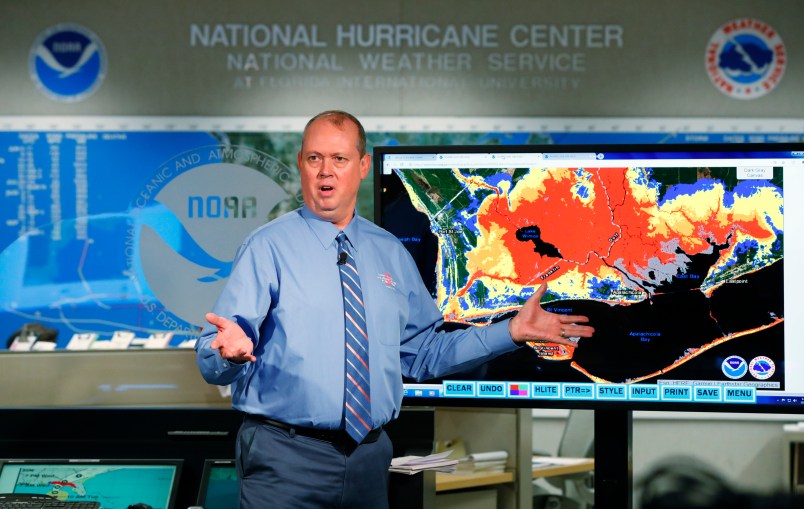TALLAHASSEE, Fla. (AP) — A fast and furious Hurricane Michael sped toward the Florida Panhandle on Tuesday with 120 mph winds and a potential storm surge of 13 feet, giving tens of thousands of people precious little time to get out or board up.
Drawing energy from the warm waters of the Gulf of Mexico, the storm strengthened rapidly into a potentially devastating Category 3 by evening. It was expected to blow ashore around midday Wednesday near Panama City Beach, along a lightly populated stretch of fishing villages and white-sand spring-break beaches.

While Florence took five days between the time it turned into a hurricane and the moment it rolled into the Carolinas, Michael gave Florida what amounted to two days’ notice. It developed into a hurricane on Monday, and by Tuesday, more than 140,000 people were under mandatory evacuation orders.
“We don’t know if it’s going to wipe out our house or not,” Jason McDonald, of Panama City, said as he and his wife drove north into Alabama with their two children, ages 5 and 7. “We want to get them out of the way.”
Coastal residents rushed to board up their homes and stock up on bottled water and other supplies.
As of 5 p.m. EDT, Michael was 295 miles (470 kilometers) south of Panama City, speeding northward at 12 mph (19 kph). Hurricane-force winds extended outward 45 miles (75 kilometers) from its center.
Florida Gov. Rick Scott warned it was a “monstrous hurricane,” and his Democratic opponent for the Senate, Sen. Bill Nelson, said a “wall of water” could cause destruction along the Panhandle.
“Don’t think that you can ride this out if you’re in a low-lying area,” Nelson said on CNN.
But some officials were worried by what they weren’t seeing — a rush of evacuees.
“I am not seeing the level of traffic on the roadways that I would expect when we’ve called for the evacuation of 75 percent of this county,” Bay County Sheriff Tommy Ford said.
Aja Kemp, 36, planned to stay in her mobile home in Crawfordville. She worked all night stocking shelves at a big-box store that was closing later Tuesday, then got to work securing her yard.
Kemp said the bill totaled over $800 when she and her family fled Hurricane Irma’s uncertain path last year.
“I just can’t bring myself to spend that much money,” she said. “We’ve got supplies to last us a week. Plenty of water. I made sure we’ve got clean clothes. We got everything tied down.”
In the dangerously exposed coastal town of Apalachicola, population 2,500, Sally Crown planned to go home and hunker down with her two dogs.
“We’ve been through this before,” she said. “This might be really bad and serious. But in my experience, it’s always blown way out of proportion.”
Mandatory evacuation orders went into effect in Bay County for people in Panama City Beach and other low-lying areas in the bull’s-eye.
In Escambia County, on the western edge of the Panhandle, evacuations began in Pensacola Beach and other vulnerable areas, but not in Pensacola itself, a city of about 54,000.

Forecasters said parts of the Panhandle and Florida’s marshy, lightly populated Big Bend area — the crook of Florida’s elbow — could see 9 to 13 feet (2.7 to 4 meters) of storm surge.
About 20 miles in from the coast, in Tallahassee, the state capital, people rushed to fill their gas tanks and grab supplies. Many gas stations in Tallahassee had run out of fuel, including the Quick ‘N’ Save, which was also stripped clean of bottled water and down to about two dozen bags of ice.
Tallahassee Mayor Andrew Gillum, Florida’s Democratic nominee for governor, helped people fill sandbags.
Several people were taken by van from coastal Wakulla County to Tallahassee’s Leon County to the north. Wakulla County’s shelters are not considered reliable against storms stronger than a Category 2.
Annette Strickland, 75, arrived at a Tallahassee high school. While glad to have a safe place to ride out the storm, she wasn’t happy that her home county couldn’t provide shelter.
“I feel like that they should’ve provided something,” she said. “That’s just me. I don’t want to be ugly.”
Michael could dump up to a foot (30 centimeters) of rain over some Panhandle communities before its remnants go back out to sea by way of the mid-Atlantic states over the next few days.
Forecasters said it could bring 3 to 6 inches of rain to Georgia, the Carolinas and Virginia, triggering flash flooding in a corner of the country still recovering from Florence.
“I know people are fatigued from Florence, but don’t let this storm catch you with your guard down,” North Carolina Gov. Roy Cooper said, adding, “A number of homes have rooftop tarps that could be damaged or blown away with this wind.”
While Florence wrung itself out for days and brought ruinous rains, fast-moving Michael is likely to be more about wind and storm surge.
As the storm closed in on the U.S., it caused havoc in the Caribbean.
In Cuba, it dropped more than 10 inches (27 centimeters) of rain in places, flooding fields, damaging roads, knocking out power and destroying some homes in the western province of Pinar del Rio. Cuban authorities said they evacuated about 400 people from low-lying areas.
Disaster agencies in El Salvador, Honduras and Nicaragua reported 13 deaths as roofs collapsed and residents were carried away by swollen rivers.



